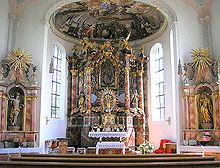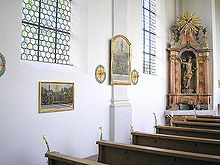Pilgrimage Church Maria Aich (Peißenberg)
The baroque pilgrimage church Maria Aich is located on the eastern outskirts of Peißenberg in the district of Weilheim-Schongau in Upper Bavaria . The externally simple church houses two important ceiling frescoes by the local master Matthäus Günther .
history
In 1631 Matthias and Anna Liebhart donated a stone chapel to "Our Lady of Victory" on the Aichanger on the outskirts. The title “Mary of Victory” recalls the triumph of the Christian armed forces over the Turks in the sea battle of Lepanto . In the chapel, a late Gothic figure of the Virgin Mary was set up, which the family had owned for a long time. Two years earlier, around 60 people had fallen victim to the plague in Peißenberg .
Shortly after the start of construction, some "miracles" allegedly occurred, which popular belief interpreted as heavenly approval for the construction of the chapel. The hens of the donor couple are said to have laid eggs whose shells were decorated with "sun rays". Such radial inclusions still occasionally occur in chicken eggs today, but can be explained scientifically. The rural population, badly affected by the effects of the Thirty Years' War , had great expectations of such phenomena. Numerous “clergy and secular persons” also personally inspected the miraculous signs in Peißenberg.
During the Spanish War of Succession , the chapel was looted and desecrated in 1704. At that time the parish priest also lost his life ( votive picture in the church).
A lively local pilgrimage soon developed around the foundation of the two farmers . In 1731 the construction of a stone pilgrimage church began, which was particularly supported by Albertus Oswald, the provost of the nearby Polling monastery . The new building was started under Pastor Dominikus Bartholomaedi, a conventual of the monastery.
In 1734 the church was completed and was consecrated on May 17th. The architect has not survived, but the design is generally attributed to the Wessobrunn master Joseph Schmuzer . The economical stucco decoration in the pendent floors of the nave and on the choir arch was probably also made by Schmuzer . The frescoes in the nave and in the choir were created by Matthäus Günther, whose birthplace was just a few kilometers above the church on the eastern slope of the Hohen Peißenberg.
The altars originate according to tradition, from the construction period. Stylistic features, however, suggest a somewhat later creation (around 1750/55). The two side altars were also reworked in 1793 in classical forms.
From 1966 the pilgrimage church was completely renovated and in 1969 it was equipped with a modern mechanical slider-chest organ (12 registers, 2 manuals, pedal) from the company Zeilhuber und Sohn (Altstätten near Sonthofen ).
description
Exterior construction
The simple church building is visible from afar in the plain in front of the Hohen Peißenberg . The white plastered church is only structured by pilaster strips and high, arched, closed window openings. Longitudinal and transverse bands are placed on the west facade.
The nave and the somewhat narrower (retracted) choir are combined by a common roof structure. The eaves cornice of the nave is strongly profiled.
A graceful tower with a bell dome rises above the chancel in the east, with a two-storey sacristy extension in front of it.
inner space
The spacious hall of the nave is subdivided into three bays by pilasters and spanned by a longitudinally oval, flat pendent dome. A circular domed vault is drawn in over the semicircular closed choir, which rests on spandrels against the arch. The peculiar construction of the choir vault corresponds to other church buildings by Joseph Schmuzer (Garmisch, Bauerbach, Grasleiten) and is an indication of the attribution of the church building to this master.
In addition to the restrained stucco decorations in the spandrels and pendentives, Günther's two ceiling paintings shape the impression of the room. The illusionistic pseudo-architecture of the painting refers to the real space. Between the painted belt arches of the nave ceiling, the view reaches up to the sky. In the center of the main picture the representation of the "Maria vom Siege" is enthroned in a dome and is surrounded by the cardinal virtues. Outside, the archangels fight vices (east), heresy represented as Lutherans (west), war and plague (north) and sin, death and the devil (south). The four evangelists can be recognized in the cartouches in the pendentives.
The dome fresco of the choir shows the coronation of Mary and the adoration of the Blessed Mother by the four continents. The work bears Günther's signature on the lower edge.
Furnishing
The four-column high altar fills the entire end of the choir. The oil painting (mid 17th century) in the center shows Maria above the town of Peißenberg. Below is the late Gothic miraculous image of Our Lady on the crescent moon (early 16th century) on the tabernacle . The side statues of St. Joachim and Anna are considered the works of Franz Xaver Schmädl from Weilheim .
The two small, classical revised side altars were placed at an angle in the choir corners. The wooden figures of hll. Sebastian and Leonhard (south) in the altar niches are attributed to Anton Sturm from Füssen . (around 1750/55).
Two votive pictures in the nave (1631 and 1704) were renewed in 1866 (Joseph Mangold) together with the large plaque (west wall) to commemorate the foundation of the original chapel.
Since the renovation in 1966, a modern metal grille in front of the new organ prospect has blocked entry into the church outside of church service times.
literature
- Georg Dehio: Handbook of German Art Monuments, Bavaria IV: Munich and Upper Bavaria (edited by Ernst Götz, Heinrich Habel and others). 3rd updated edition, Munich 2006. ISBN 3-422-03115-4
- Willi Mauthe: The churches and chapels in Peißenberg and Ammerhöfe . Peißenberg 1969 (reprint 1989)
- Georg Paula , Stefanie Berg-Hobohm : District Weilheim-Schongau (= Bavarian State Office for Monument Preservation [Hrsg.]: Monuments in Bavaria . Volume I.23 ). Lipp, Munich 2003, ISBN 3-87490-585-3 , pp. 222-224 .
Web links
Coordinates: 47 ° 48 ′ 25 " N , 11 ° 4 ′ 57.5" E





